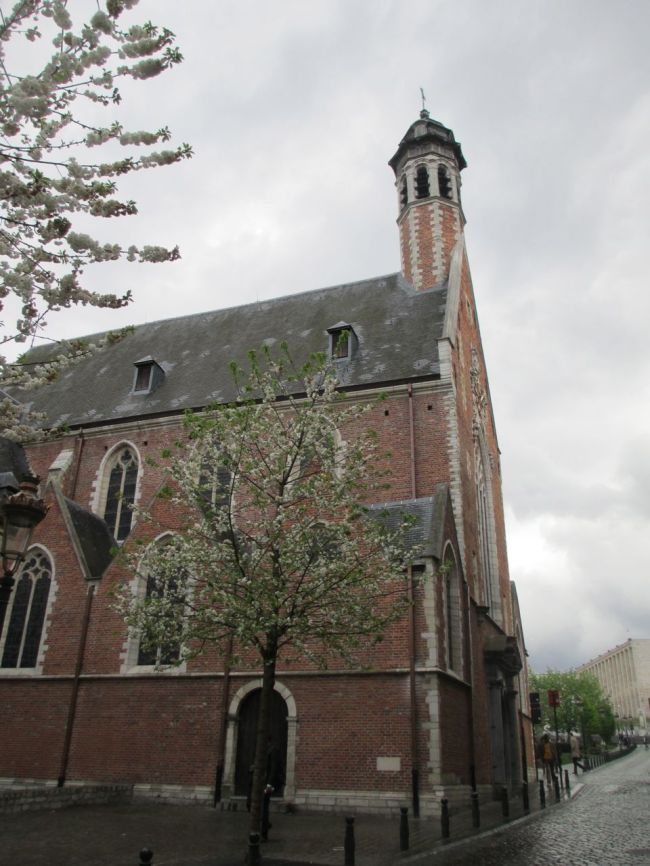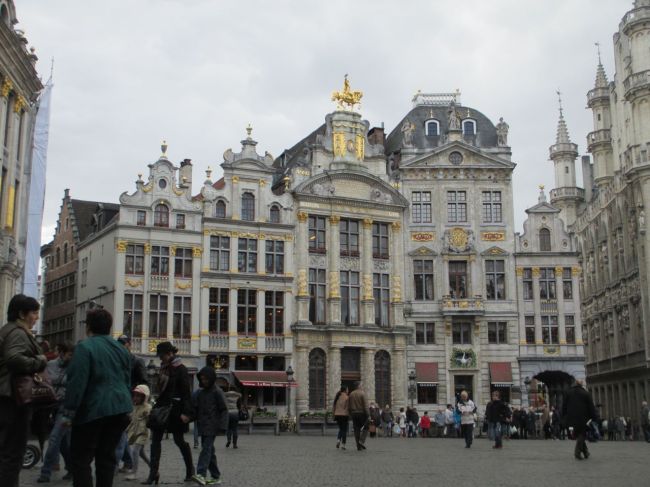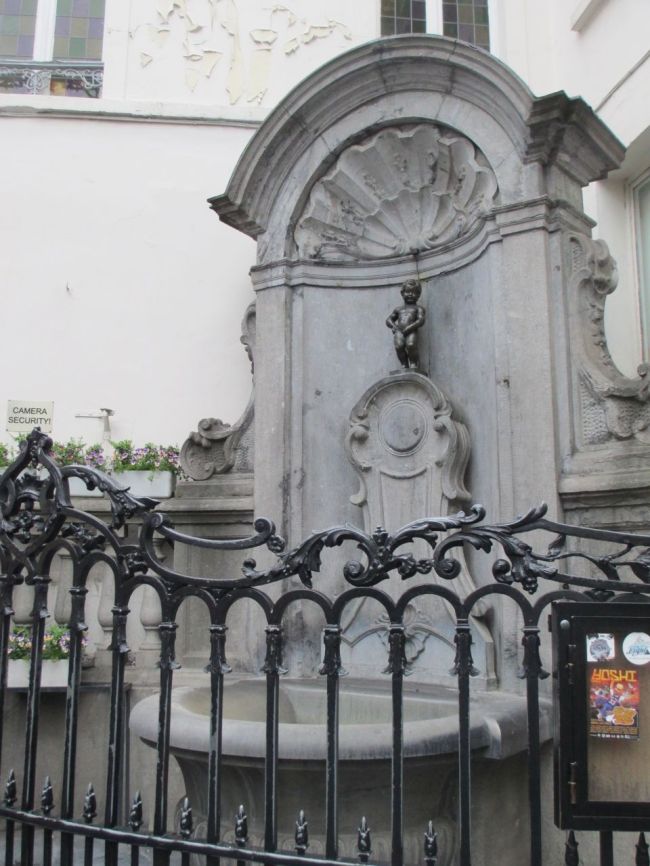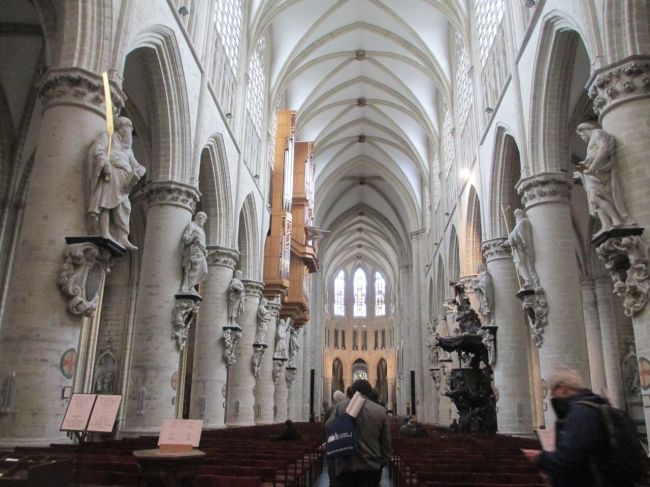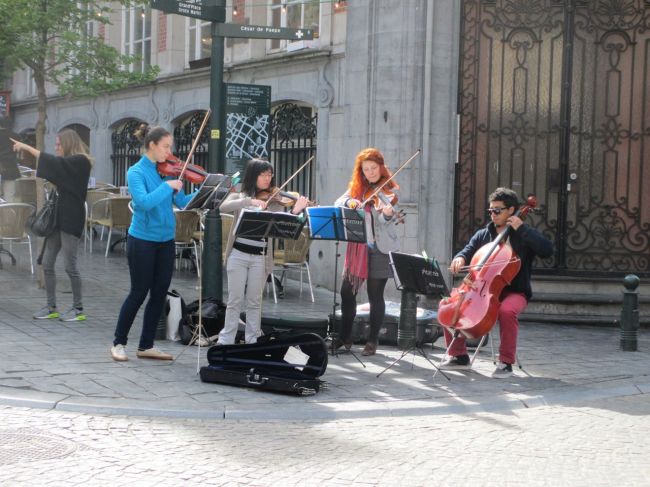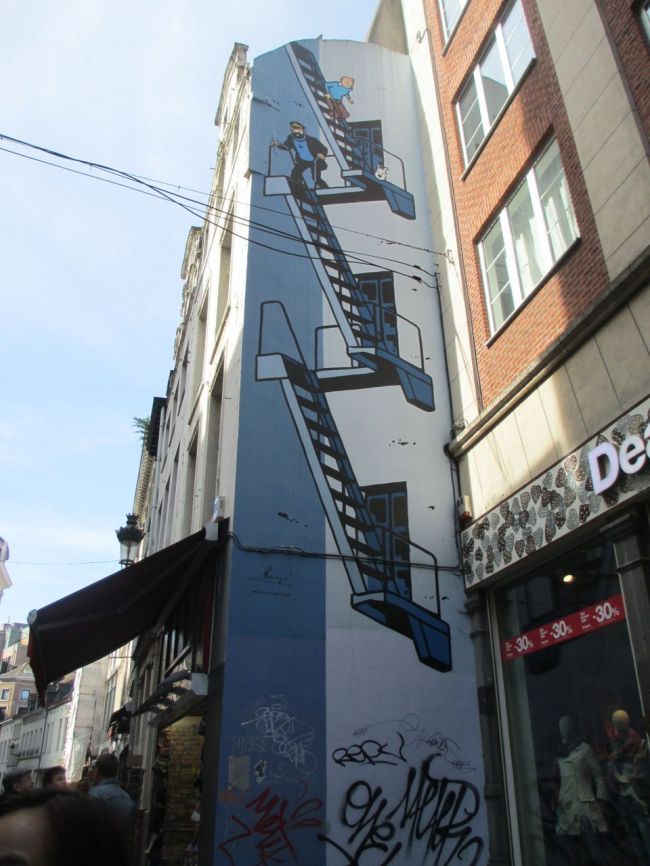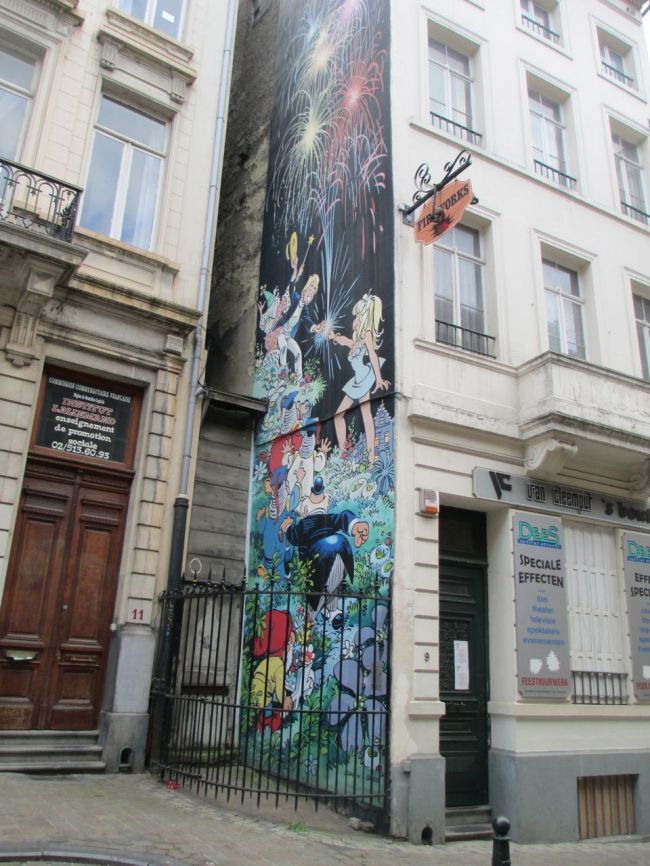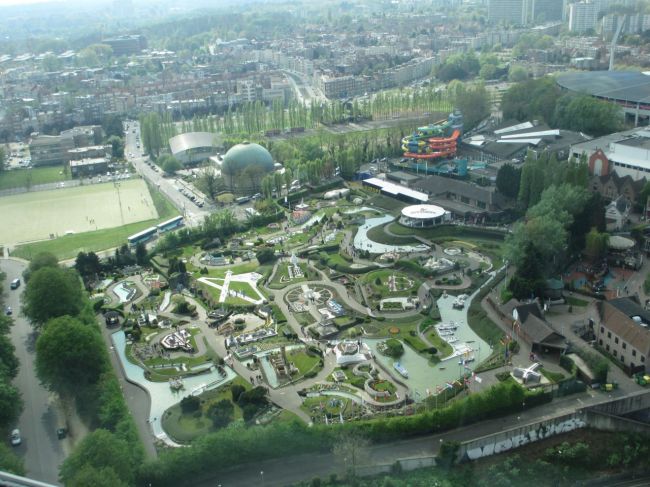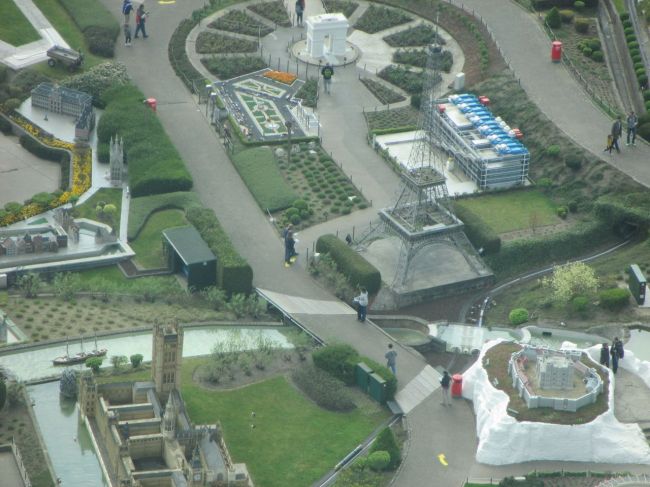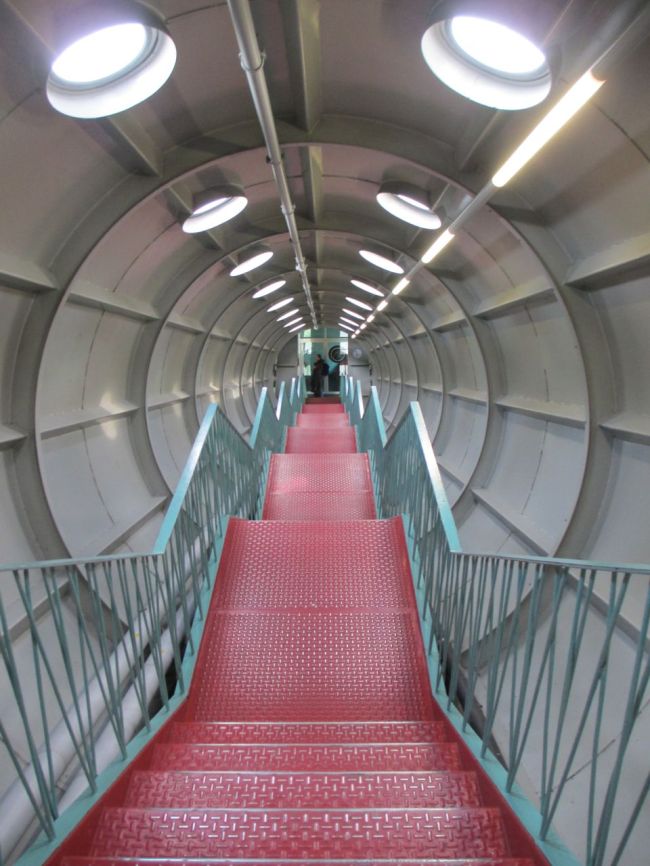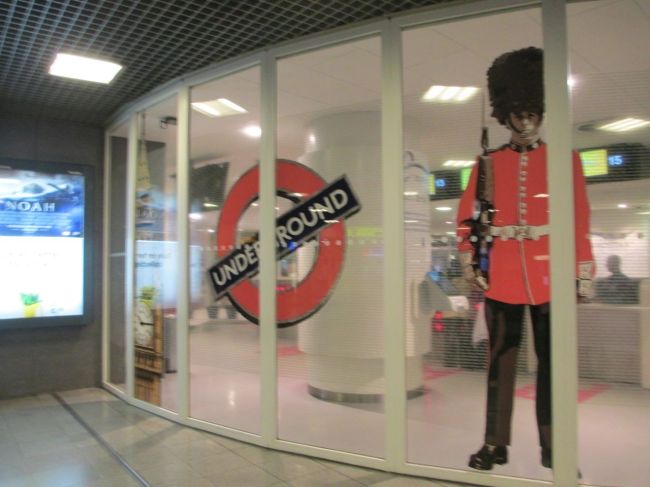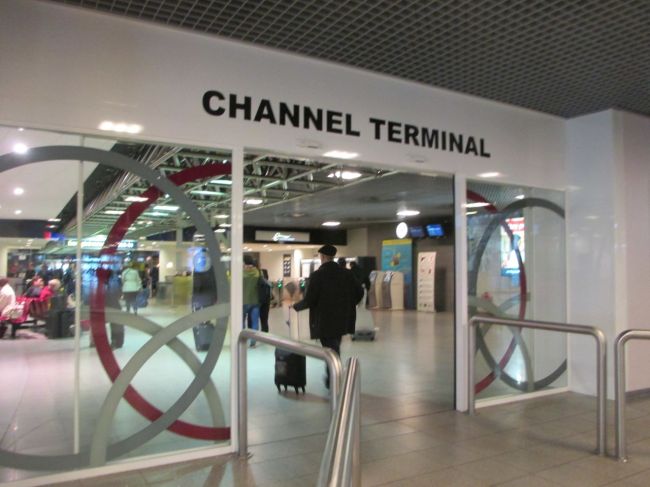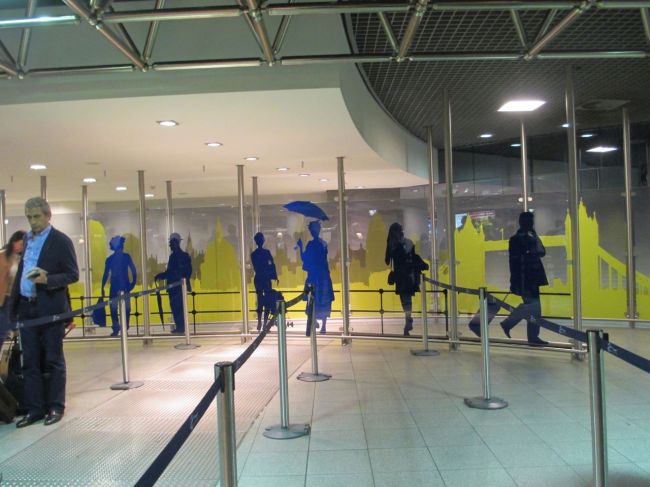We left Amsterdam on a 9:18 train to Brussels and arrived at 11:08. We split up at the train station, since Caroline, Carla, Rachel, and Blair were continuing on to London later in the day, but Cassie and I wanted more time in Brussels. The first thing Cassie and I did was go to our hotel, but the directions from the website were terrible, so it took a little while to figure out how to get there. We eventually figured out that the best way to get there would be by metro and then the tram. It was a little tricky with our luggage, and we decided we’d treat ourselves to a taxi on the way back to the train station the next day!
After being armed with a map from reception, we headed out to do some exploring. We walked down the street and got a good view of the city from the Palace of Justice and the WWI and WWII monument in Place Poelaertplein. Then we continued down the road and went in Eglise Notre Dame au Sablon. The church was pretty, but Cassie and I were quite taken with the beautiful park across the street. The tulips and shrubbery were beautiful. There was a statue and fountain at the end of the little garden.
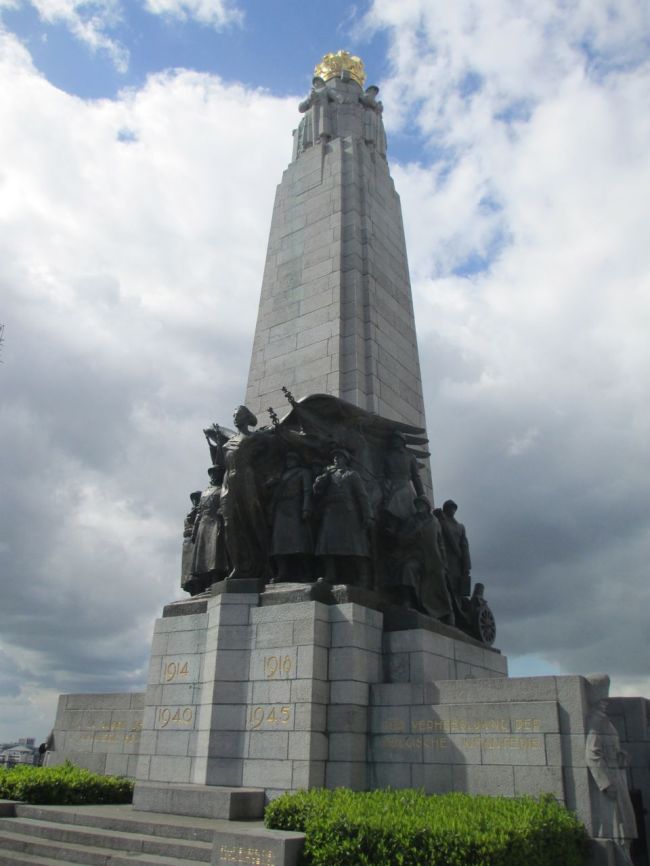

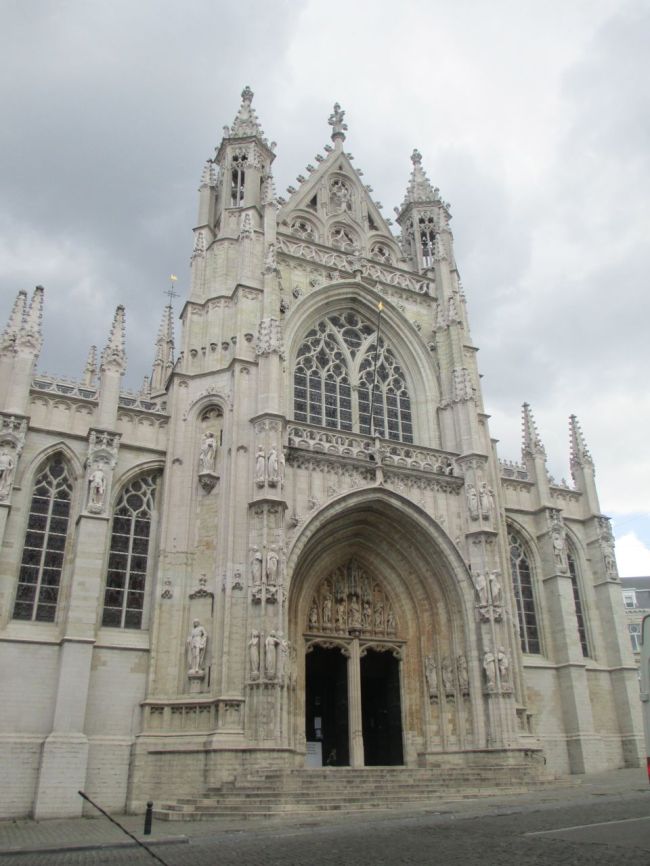
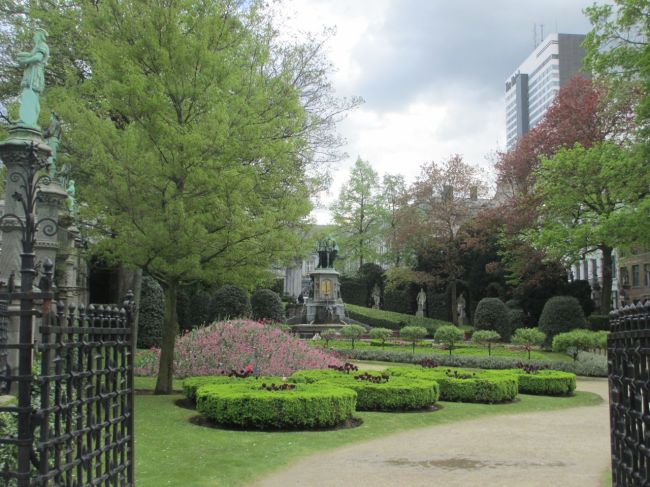
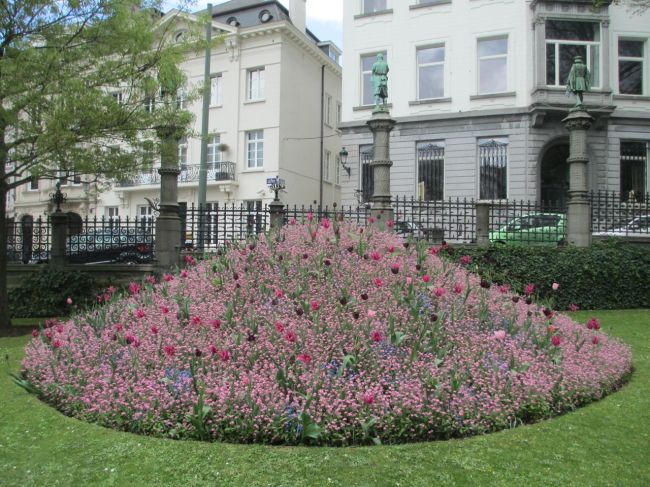
 Next, we walked through the museum area and went in the gift shop of one of them – lots of Brughel, art nouveau, and some Van Gogh. Based on the prints and postcards available in the gift shop, I’d like to go to this museum on my next trip to Brussels. Only a few hours in and I’ve already decided I want to go back! We walked down some stairs across from the Place Royale, dodging the off and on rain.
Next, we walked through the museum area and went in the gift shop of one of them – lots of Brughel, art nouveau, and some Van Gogh. Based on the prints and postcards available in the gift shop, I’d like to go to this museum on my next trip to Brussels. Only a few hours in and I’ve already decided I want to go back! We walked down some stairs across from the Place Royale, dodging the off and on rain.
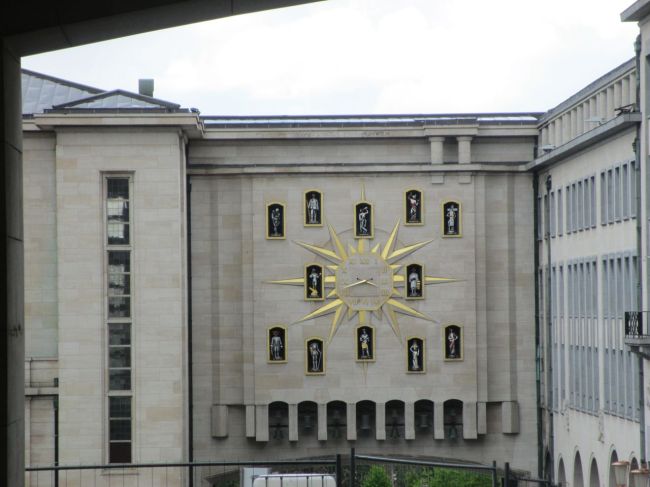
 We went into the Chapel of the “Madeleine” and then went to the Grand Place! All of the buildings were really ornate. Cassie and I ducked into most of the souvenir shops on the hunt for the perfect pin for Cassie and patch for me. I also bought a tiny Mannekin-Pis statue for my dad (if you’re unaware of Mannekin-Pis, keep reading).
We went into the Chapel of the “Madeleine” and then went to the Grand Place! All of the buildings were really ornate. Cassie and I ducked into most of the souvenir shops on the hunt for the perfect pin for Cassie and patch for me. I also bought a tiny Mannekin-Pis statue for my dad (if you’re unaware of Mannekin-Pis, keep reading).
Then…..THEN….we got waffles. Most of the countries I’ve been to have famous foods that I’ve been told to try, and I usually enjoy them. But nothing prepared me for Belgian waffles. There is nothing hyperbolic to be said about them, because they are as amazing as anyone could describe them to be. I still dream about them and will be vouching that they are worth the hype for the rest of my life. In America, a Belgian waffle is basically just a big, circular waffle. In Belgium, they’re made with dough rather than batter. So the waffle is really thick and full of doughy goodness. I got my first one with chocolate and bananas on top and it was heavenly.


 After our brush with heaven, we stopped by an info place to pick up some real maps and chat with the friendly info workers. They told us we should go to Mannekin-Pis. Mannekin-Pis is a statue of a little boy peeing, and there’s a pool below him that collects the water exiting his little body. It’s one of Brussels most famous and treasured spots, for tourists and Belgians alike. Supposedly he represents the free spirit and creativity of the people of Brussels. Honestly, it was very anti-climactic, but he is a quirky symbol of the city, so we had to see him. We also went into the Cathedral of St. Michael and St. Gudula.
After our brush with heaven, we stopped by an info place to pick up some real maps and chat with the friendly info workers. They told us we should go to Mannekin-Pis. Mannekin-Pis is a statue of a little boy peeing, and there’s a pool below him that collects the water exiting his little body. It’s one of Brussels most famous and treasured spots, for tourists and Belgians alike. Supposedly he represents the free spirit and creativity of the people of Brussels. Honestly, it was very anti-climactic, but he is a quirky symbol of the city, so we had to see him. We also went into the Cathedral of St. Michael and St. Gudula.
We got dinner at an Irish pub, and when we left, around 7:30 pm, it was still just as bright out as it was when we went in! Despite the gorgeous weather, we decided to head back to our hotel to relax and get a good night’s sleep.
The next morning, we got breakfast and stored our luggage before heading out. I wanted to do a walking tour, so Cassie went to the Parliamentarium, which is a museum about the European Union (which she loved and highly recommended). We agreed to meet at the Trône metro station at 3 pm.
I took the metro and did some walking to end up at the Grand Place, the meeting point of the tour. I had read about a tour guide named PJ (Pieter-Jan) on TripAdvisor (which I love, and have used many a time when my plans have gone awry to figure out a new plan or even to come up with a first step) and he had many glowing reviews. I was fully prepared to head to his group even if I was assigned to another tour guide, but luckily, he was the only guide. He had a really great perspective because he grew up in Brussels, so he’s a Flemish local. He speaks English, French, and Dutch. He went to university in Ghent, where he studied biology, and actually works as a biologist when he isn’t leading tours – which seems pretty different from the other guides I’ve had.
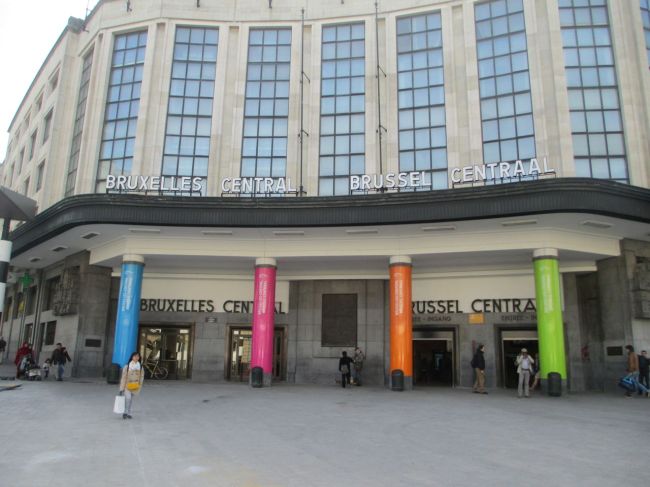 ^I think these are the colors of the Brussels’ tourist bureau
^I think these are the colors of the Brussels’ tourist bureau
We started at the Grand Place and learned about the buildings there. First, PJ talked about the town hall. It’s asymmetrical. It combines different architectural styles since it took so long to build. That doesn’t explain why it’s asymmetrical, but it’s all I remember from what he said…Then we talked about the building across from the town hall. The French call it the House of the King but the Flemish call it the Breadhouse. The French aristocracy were renovating the building so that they could receive diplomats there. The Flemish used to sell bread there, so they called it the Breadhouse.
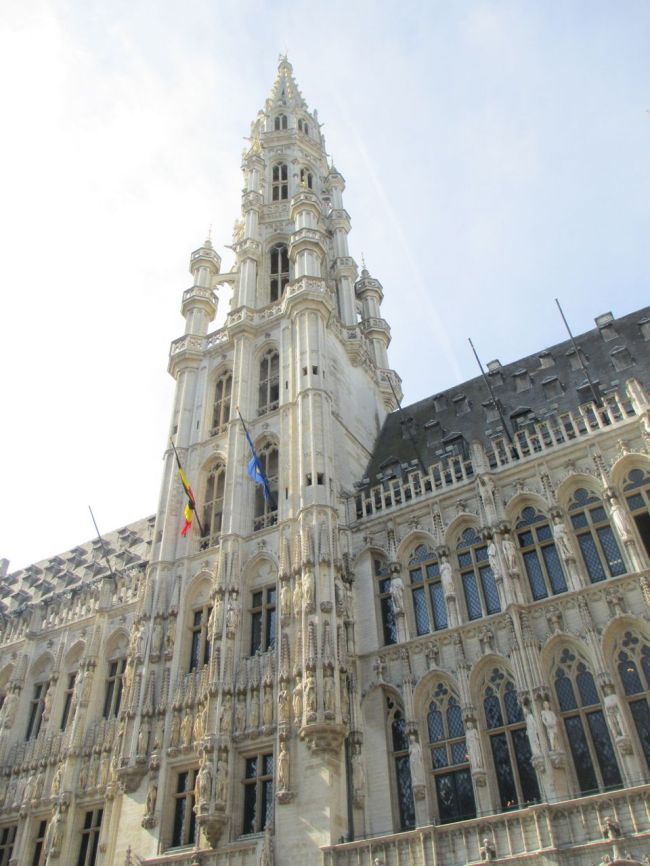
 ^the door of the town hall is off center
^the door of the town hall is off center
^the Breadhouse
The beautiful buildings between the town hall and the Breadhouse are old guild halls. Guilds are basically the labor unions of the past. The buildings were all built between 1695 and 1702. The old ones were destroyed, and so the guilds were competing over who could raise the most money to rebuild the most ornate building in the shortest amount of time. PJ told us that looking at the buildings is like looking at a moment frozen in time.
 ^PJ talking in front of the guildhalls
^PJ talking in front of the guildhalls
The last things we saw in the square were the House of the Swan, where Karl Marx lived and wrote Das Kapital. Brussels is known for treating political refugees well, but even they exiled Marx! We also saw a home famous for the magistrate who lived there, but I don’t remember what was so special about him…there was a statue of him that you could rub for good luck. His name was Everard ‘t Serclaes. At this point, PJ also taught us that north Belgium is Flanders, the people are Flemish, and they speak Dutch. Education is top notch here. Southern Belgium is Wallonia. The people are Wallonian and they speak French. Dutch is a difficult language to work. To work in Brussels, it’s good to be bilingual. So most of the people who work in Brussels are Flemish, and they commute in and out of the city. The unemployment rate for Belgians is pretty high, with 29% youth unemployment.
We walked down the road and saw a lace shop. PJ told us that Flanders is known for its textile work. He told us that if we ever see a tapestry with a green-ish tint during our travels in Europe, it’s likely that it is Flemish. (And this was proved to be true when I was in Ireland!)
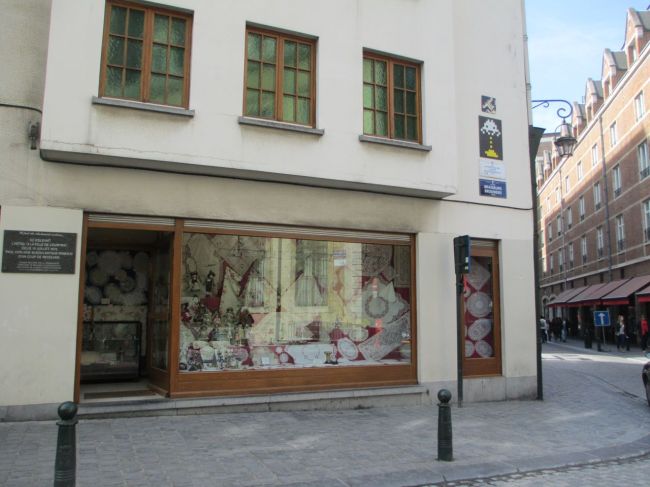 We saw a Space Invaders tile installed by an artist similar to Banksy.
We saw a Space Invaders tile installed by an artist similar to Banksy.
 Next we saw Mannekin-Pis. There are legends about why it exists – an homage to a boy putting out a fire, a missing boy with a statue of what he was doing when he was found, etc. the people dress him up for every occasion imaginable. Apparently he has his own seamstress! He was dressed as a bus driver for the 162nd birthday of the Brussels transportation system and he was dressed as a Serbian for a Serbian holiday one time. PJ said he saw him dressed as a Buckingham guard once, complete with a huge furry hat. There was a string quartet of students playing across from Mannekin-Pis, and they were really good!
Next we saw Mannekin-Pis. There are legends about why it exists – an homage to a boy putting out a fire, a missing boy with a statue of what he was doing when he was found, etc. the people dress him up for every occasion imaginable. Apparently he has his own seamstress! He was dressed as a bus driver for the 162nd birthday of the Brussels transportation system and he was dressed as a Serbian for a Serbian holiday one time. PJ said he saw him dressed as a Buckingham guard once, complete with a huge furry hat. There was a string quartet of students playing across from Mannekin-Pis, and they were really good!
 ^Mannekin-Pis in the background
^Mannekin-Pis in the background
Then we saw an art mural. Brussels is huge for comic books. Tintin is the best selling comic book of all time, and it happens to be Belgian. Belgium’s comic books are a mixture of cynical, humorous, and historical. PJ said that Astrid and Felix actually has a lot of historical accuracy. The Smurfs are also Belgian! The first art mural was painted in 1990. The city was removing advertisements from the walls, leaving them in bad shape. The murals add color and charm. The first one is a picture of a guy and girl walking down the street. Everyone thought the girl looked like a guy, so the city made the artist add earrings, longer hair (it’s still VERY short), and wider hips to the girl. This area of Brussels is now the gay district…
After that, we saw the old stock exchange building. Brussels formed a stock exchange with Paris and Amsterdam, but it was absorbed by the NYSE a few years ago. Now the buildings is used for exhibitions. Then we walked to the Theatre Royal de la Monnaie – named as such because it used to be the mint. PJ told us about the history of Brussels and then we took a quick break.
^old stock exchange
^Theatre Royale de la Monnaie
We walked inside Galeries Royales St. Hubert. It’s basically a beautiful covered walkway full of nice shops, and one of the first in Europe. There’s one in Milan based off of this one. The praline was invented here. PJ told us about Belgian fries, waffles, and beer. French fries are actually Belgian fries. They’re only called French in North America because the Canadians and Americans ate them while fighting alongside French speakers (Belgians) in WWI. Waffles are made with a sugary dough. The special kind is called a liege waffle. There is also an oval one. PJ also mentioned the “tourist waffle” – covered with everything imaginable.
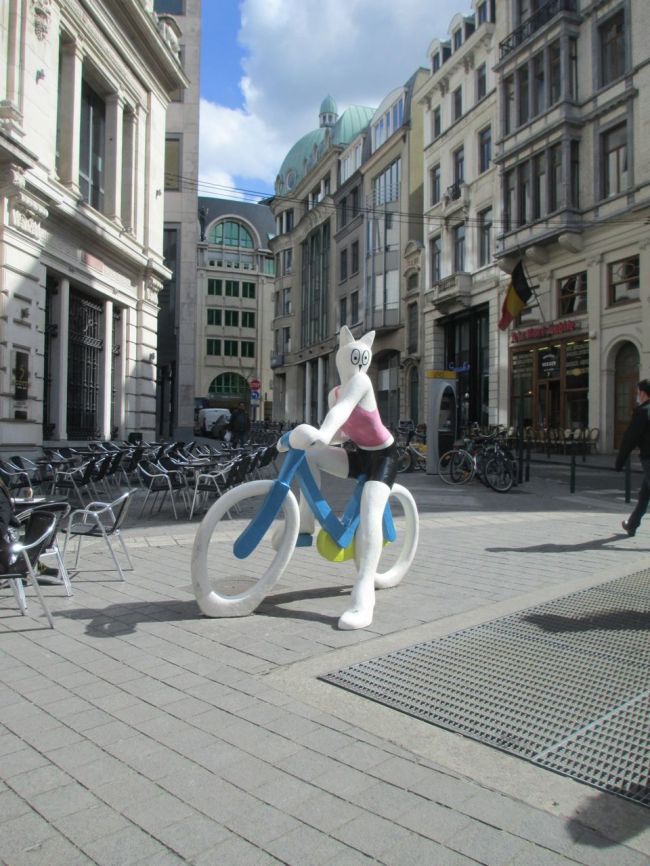
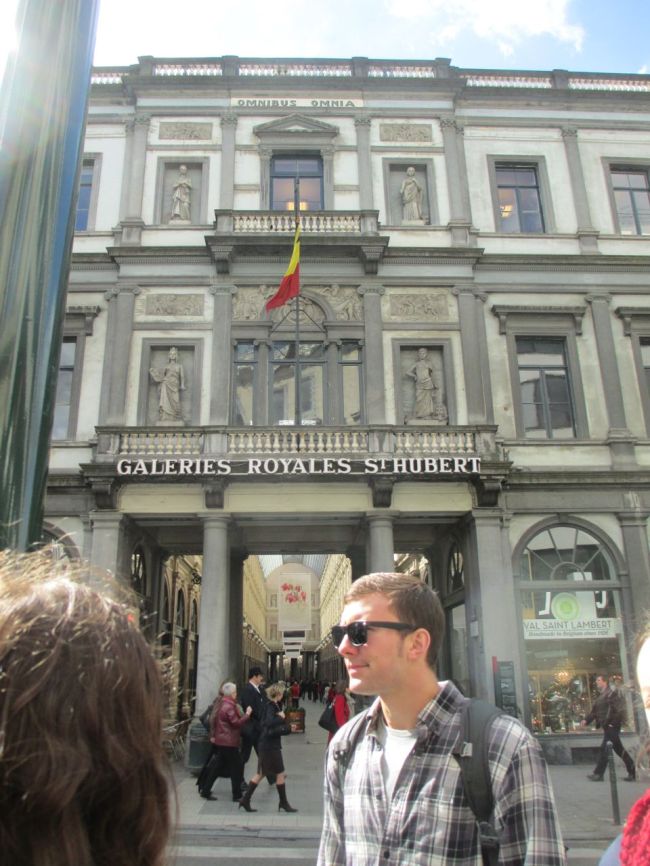
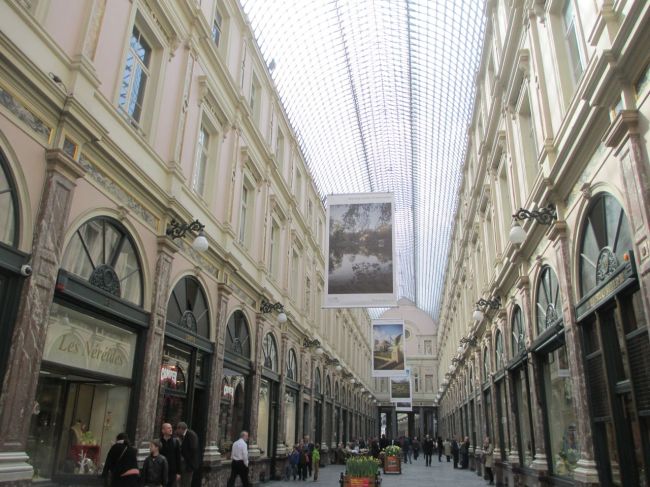 Next, we saw the Cathedral. A cathedral is different from a church because it has a bishop who oversees all of the churches/priests in the area. Cathedrals also need a holy relic. The one here is St. Gudula. The cathedral has a gothic design, and PJ noted the difference between gothic architecture and today’s “gothic” teens.
Next, we saw the Cathedral. A cathedral is different from a church because it has a bishop who oversees all of the churches/priests in the area. Cathedrals also need a holy relic. The one here is St. Gudula. The cathedral has a gothic design, and PJ noted the difference between gothic architecture and today’s “gothic” teens.
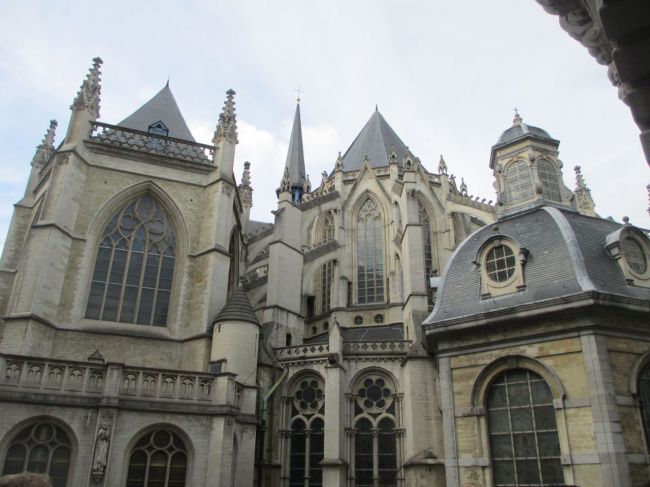 We walked through the edge of the Parc de Bruxelles, which is designed to look like the symbol of the Free Masons (you can tell by looking at it on a map, but not while you’re in it). They paid for the park. We ended at the WWI and II memorial overlooking a beautiful garden with some fountains, and the museum area was nearby. This last stop had a nice view of the city.
We walked through the edge of the Parc de Bruxelles, which is designed to look like the symbol of the Free Masons (you can tell by looking at it on a map, but not while you’re in it). They paid for the park. We ended at the WWI and II memorial overlooking a beautiful garden with some fountains, and the museum area was nearby. This last stop had a nice view of the city.
 PJ told us about Belgium in the world wars. In WWI, King Albert wanted to keep Brussels and Belgium neutral. But the Germans wanted to march straight through to get to France. Albert proclaimed that Belgium was a nation, not a road. The Belgians fought harder than the Germans expected, allowing the British and French time to prepare to fight.
PJ told us about Belgium in the world wars. In WWI, King Albert wanted to keep Brussels and Belgium neutral. But the Germans wanted to march straight through to get to France. Albert proclaimed that Belgium was a nation, not a road. The Belgians fought harder than the Germans expected, allowing the British and French time to prepare to fight.
PJ was very passionate about the fact that the French are applauded for the Resistance during WWII, which was very important, but no one remembers that the Vichy government was the biggest collaborator with the Nazis. Hitler only sent two troops to fight the Belgians. It was hard to find a natural stronghold in such a flat country, but they found one at the Albert River. They refused Hitler’s first offer but accepted his second since they had no choice.
PJ was so passionate about this because his family fought in these wars. His grandmother’s grandfather died at Flanders Fields in WWI, a week after his 30th birthday. His paternal grandfather was captured by the Germans and placed in a POW camp in Poland, where he spent five years. He walked back 800 tough miles with his former guard and another man. They saw villages ravaged by war. His dad met his father for the first time at the train station after the war.
PJ mentioned that many people don’t come to Brussels by choice – it’s the easiest way to get from Amsterdam to Paris, or people have a layover, etc. This was funny because it’s exactly what my friends did yesterday. I’ve actually wanted to go to Brussels for a while, though, and I would love to go back. He urged us not to forget Brussels, which was a poignant and dramatic way to end the tour.
Luckily, the tour ended near a waffle van, so I was able to procure some sustenance. This time I got one with just whipped cream on it, and it was just as delicious as the one I bought the day before. PJ told us that the waffle vans are sometimes the best place to get waffles since they don’t have room to stock up and therefore have to make the waffles fresh.
Cassie and I met at Trone at 3 and took the metro out to Heizel. It was a five minute walk from the station to the Atomium, which is like the Eiffel Tower of Brussels, although I hadn’t heard about it until some other CIMBA kids went there. It was built for the 1958 World’s Fair and not intended to survive beyond the fair.
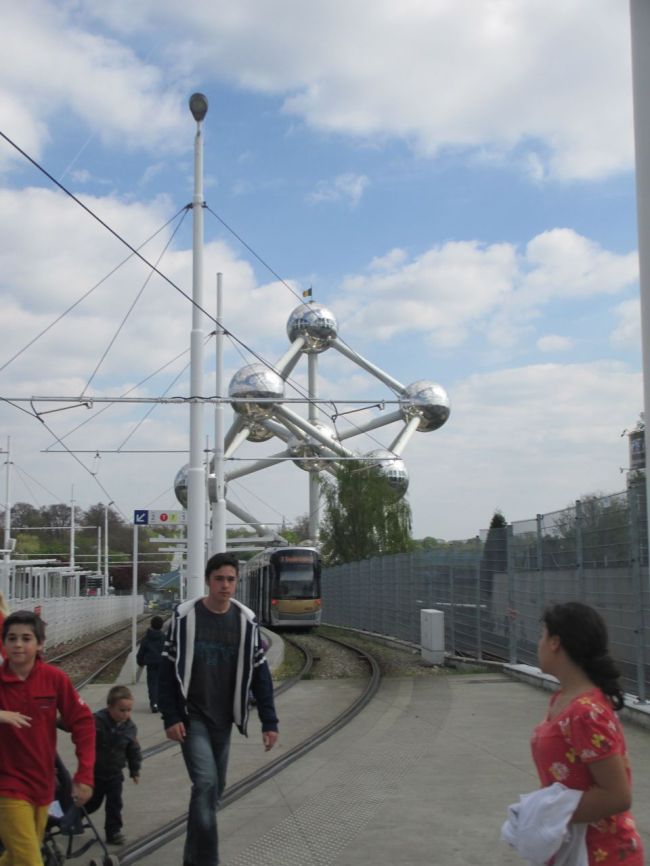 First, we took an elevator up to the top (in 22 seconds). In 1958, it was the world’s fastest elevator. There was a panoramic view at the top with signs pointing out different things on the ground, including other fair remnants and the direction and distance to major cities like New York. We then took the elevator back down and took the escalator up to two spheres about the World’s Fair and the Atomium. The fair hostesses were beautiful, young, multilingual women. There was also a temporary exhibit called Mobilia, about 100 years of architecture and design in Belgium.
First, we took an elevator up to the top (in 22 seconds). In 1958, it was the world’s fastest elevator. There was a panoramic view at the top with signs pointing out different things on the ground, including other fair remnants and the direction and distance to major cities like New York. We then took the elevator back down and took the escalator up to two spheres about the World’s Fair and the Atomium. The fair hostesses were beautiful, young, multilingual women. There was also a temporary exhibit called Mobilia, about 100 years of architecture and design in Belgium. 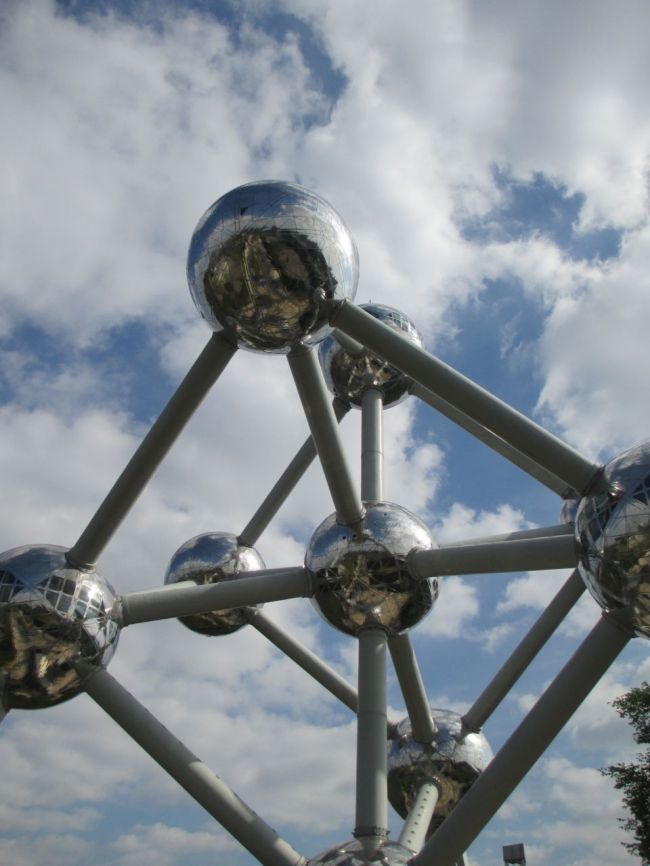
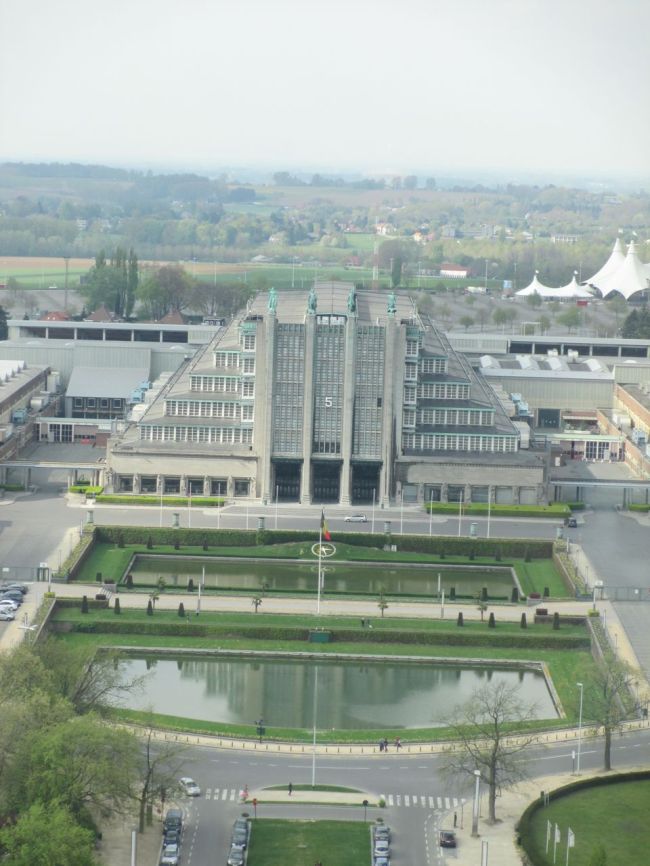 ^exhibition building from 1935 (viewed from the top of the Atomium)
^exhibition building from 1935 (viewed from the top of the Atomium)
^view of Little Europe
^staircase between spheres
We did a little photo shoot out on the lawn in front of the Atomium. I heard two guys say “scusate!” (excuse me in Italian) and I turned around and took a picture for them. When they thanked me I said “prego!” and they asked “parli italiano?” We chatted quickly about my semester in Italy and it was fun to briefly speak Italian again!

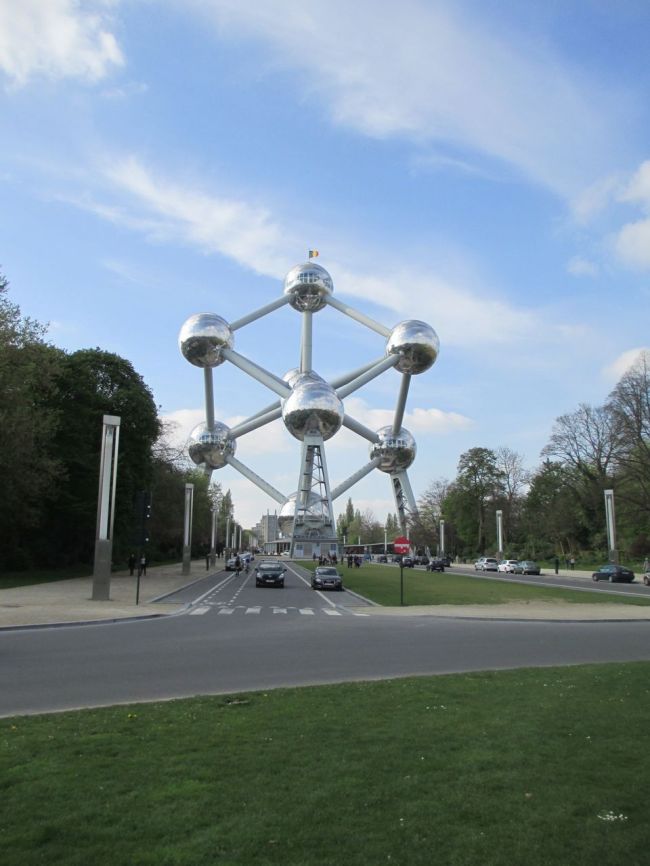 We went back to the hotel, got our luggage, and took a taxi to the station. I had Subway for dinner!!! I never thought I would miss Subway, but it really hit the spot. To get to London, we had to go through the English Channel, so we had tickets for the Eurostar train. Belgium is in the Schengen area and England is not, so we entered the Channel Terminal rather than the Schengen Terminal. We filled out our landing cards at the station. There were British border agents who looked at our passports and stamped them there, so we were technically in the UK as soon as we got on the train. We took a sloped conveyor belt up to our platform and got our stuff situated. This was definitely the most stress-free train experience I’ve had!
We went back to the hotel, got our luggage, and took a taxi to the station. I had Subway for dinner!!! I never thought I would miss Subway, but it really hit the spot. To get to London, we had to go through the English Channel, so we had tickets for the Eurostar train. Belgium is in the Schengen area and England is not, so we entered the Channel Terminal rather than the Schengen Terminal. We filled out our landing cards at the station. There were British border agents who looked at our passports and stamped them there, so we were technically in the UK as soon as we got on the train. We took a sloped conveyor belt up to our platform and got our stuff situated. This was definitely the most stress-free train experience I’ve had!
^some Londoners…including Mary Poppins!
The view outside the windows was beautiful. The sun was setting and the fields were so green. The houses were different from those in Italy. Mom wanted me to “soak up” my chunnel (channel tunnel) experience but I didn’t even notice when we went in. It was very anti climactic. There was no announcement and I only noticed because we entered a tunnel. The underwater leg of the journey only lasts about 30 minutes.
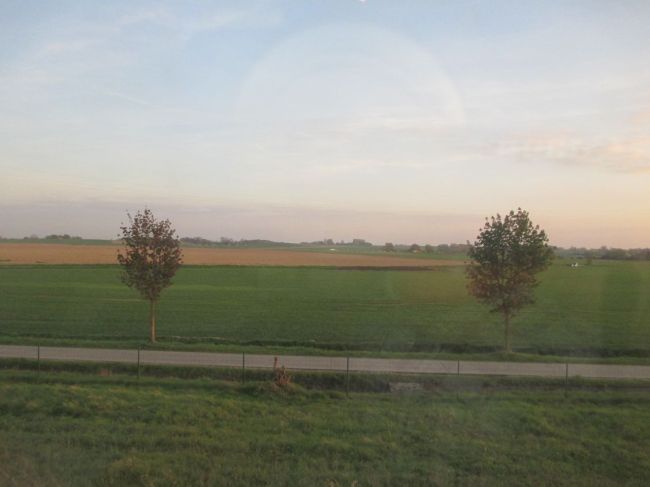
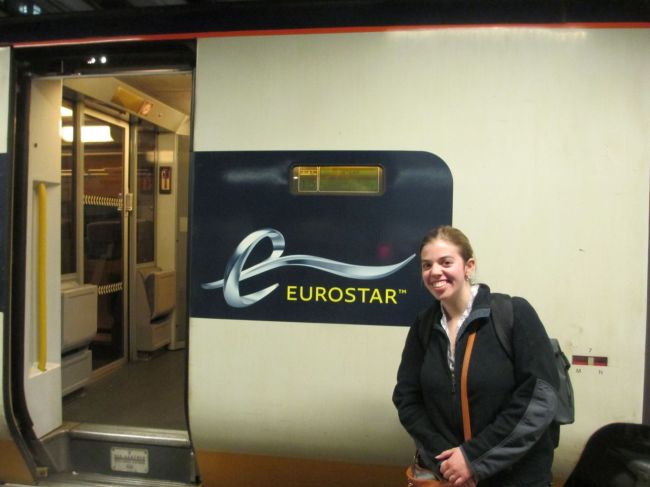 ^outside the train in London
^outside the train in London  ^Cassie on the sloped conveyor belt
^Cassie on the sloped conveyor belt
We arrived at St. Pancras International Station around 9 pm local time. Confusingly, it’s in the same place as King’s Cross, which is a national station. We walked about five minutes to our hostel, met up with the girls, and checked in. We spent the next day in London, and I’ll write about that next time!
